

Сервис-ориентированная архитектура. Программные комплексы, разработанные в соответствии с сервис-ориентированной архитектурой, обычно реализуются как набор веб-служб, взаимодействующих по протоколу SOAP, но существуют и другие реализации (например, на базе jini, CORBA, на основе REST).
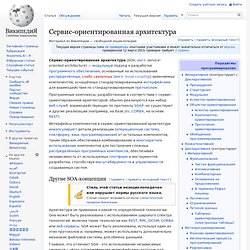
Другие SOA-концепции[править | править исходный текст] Архитектура не привязана к какой-то определённой технологии. Она может быть реализована с использованием широкого спектра технологий, включая такие технологии как REST, RPC, DCOM, CORBA или веб-сервисы. SOA может быть реализована, используя один из этих протоколов и, например, может использовать дополнительно механизм файловой системы для обмена данными. Welcome to Everware - CBDI Forum. Service-oriented modeling.
Example of a Service-Oriented Modeling Framework (SOMF) Diagram.

Service-oriented modeling is the discipline of modeling business and software systems, for the purpose of designing and specifying service-oriented business systems within a variety of architectural styles, such as enterprise architecture, application architecture, service-oriented architecture, and cloud computing. Any service-oriented modeling methodology typically includes a modeling language that can be employed by both the 'problem domain organization' (the Business), and 'solution domain organization' (the Information Technology Department), whose unique perspectives typically influence the 'service' development life-cycle strategy and the projects implemented using that strategy. WSMX - Web Service Execution Environment. Semantic service-oriented architecture. A Semantic Service Oriented Architecture (SSOA) is an architecture that allows for scalable and controlled Enterprise Application Integration solutions.[1] SSOA describes a sophisticated approach to enterprise-scale IT infrastructure.
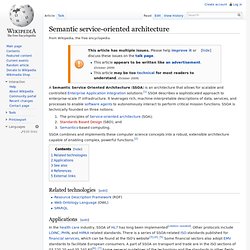
It leverages rich, machine-interpretable descriptions of data, services, and processes to enable software agents to autonomously interact to perform critical mission functions. SSOA is technically founded on three notions: SSOA combines and implements these computer science concepts into a robust, extensible architecture capable of enabling complex, powerful functions.[2] Related technologies[edit] Applications[edit] In the health care industry, SSOA of HL7 has long been implemented[citation needed]. Service Component Architecture. Service Component Architecture (SCA) is a software technology created by major software vendors, including IBM, Oracle and TIBCO.
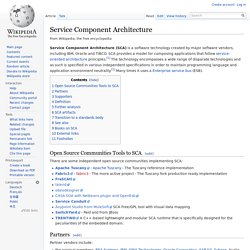
SCA provides a model for composing applications that follow service-oriented architecture principles.[1] The technology encompasses a wide range of disparate technologies and as such is specified in various independent specifications in order to maintain programming language and application environment neutrality.[1] Many times it uses a Enterprise service bus (ESB). Open Source Communities Tools to SCA[edit] There are some independent open source communities implementing SCA: Partners[edit] Partner vendors include: Supporters[edit] In addition to the partners above, the SCA community has a significant set of formal supporters.[3] The Supporters Program remains open for any interested vendor, ISV, customer or user of the SCA technology to contribute to its evolution.
DeveloperWorks : Standards and web services. Web services are a set of emerging standards that enable interoperable integration between heterogeneous IT processes and systems.

Meta Integration Technology, Inc. Service Integration Maturity Model. The Service Integration Maturity Model (SIMM) is a standardized model for organizations to guide their SOA transformation journey.

By having a standard maturity model, it becomes possible for the organizations or industry to benchmark their SOA levels, to have a roadmap for transformation to assist their planning and for vendors to offer services and software against these benchmarks. SIMM may also serve as a framework for the transformation process that can be customized to suit the specific needs of organizations and assessments. This process is a simple sequence of steps: configure the assessment framework, determine the initial level of maturity, and determine the target level of maturity and a transformation path from initial to target level. The Open Group has adopted SIMM as the foundation for the Open Group Service Integration Maturity Model (OSIMM). OSIMM is the industry's first collaborative maturity model for SOA adoption. IBM Article. Catalog of OMG Security Specifications. The assets of an enterprise need to be protected against perceived threats.
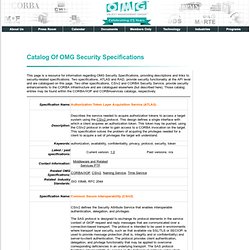
The amount of protection the enterprise is prepared to pay for depends on the value of the assets, and the threats that need to be countered. The security policy needed to protect against these threats may also depend on the environment and how vulnerable the assets are in this environment. This CORBA Security Service provides a security architecture that can support a variety of security policies to meet different needs. The security functionality defined by this specification comprises: Advantage for SOA Governance Standards. Introduction Service Oriented Architecture Governance is now widely recognized as being one of the keys to a successful Service Oriented Architecture (SOA) for an enterprise.
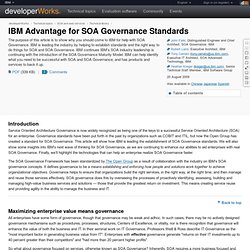
Governance standards have been put forth in the past by organizations such as COBIT and ITIL, but now the Open Group has created a standard for SOA Governance. This article will show how IBM is leading the establishment of SOA Governance standards. We will also show some insights into IBM’s next wave of thinking for SOA Governance, as we are continuing to enhance our abilities to aid enterprises with real SOA Governance. Finally, we’ll highlight the technologies that can help an enterprise realize SOA Governance faster.
The SOA Governance Framework has been standardized by The Open Group as a result of collaboration with the industry on IBM’s SOA governance concepts. SOA diagnostic. Over the years, your organization has spent considerable resources increasing the value of your business applications.
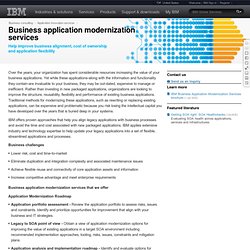
Yet while these applications-along with the information and functionality they contain-are invaluable to your business, they may be out-dated, expensive to manage or inefficient. Rather than investing in new packaged applications, organizations are looking to improve the structure, reusability, flexibility and performance of existing business applications. Traditional methods for modernizing these applications, such as rewriting or replacing existing applications, can be expensive and problematic because you risk losing the intellectual capital you have developed over the years that is buried deep in your systems. IBM offers proven approaches that help you align legacy applications with business processes and avoid the time and cost associated with new packaged applications.
Business challenges.